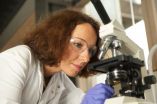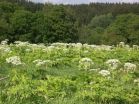(Press-News.org) PHILADELPHIA, Aug. 22, 2012 — A solution finally may be at hand for the number one consumer gripe about America's favorite fresh fruit ― bananas and their tendency to ripen, soften and rot into an unappetizing mush, seemingly in the blink of an eye.
Scientists speaking here today at the 244th National Meeting & Exposition of the American Chemical Society, the world's largest scientific society, described efforts to develop a spray-on coating that consumers could use to delay the ripening of those 6.4 billion pounds of bananas that people in the U.S. eat every year.
The coating is a so-called "hydrogel," a superabsorbent material like those with many medical and commercial uses, made from chitosan, a substance derived from shrimp and crab shells. Xihong Li, Ph.D., who presented the report, noted that chitosan is attracting considerable attention in efforts to keep fruits and vegetables fresher longer due to its action in killing bacteria that cause produce to rot, low cost and other properties. Until now, however, it has not been used to slow the ripening of bananas.
"We found that by spraying green bananas with a chitosan aerogel, we can keep bananas fresh for up to 12 days," said Li, who is the study's leader. "Once bananas begin to mature, they quickly become yellow and soft, and then they rot. We have developed a way to keep bananas green for a longer time and inhibit the rapid ripening that occurs. Such a coating could be used at home by consumers, in supermarkets or during shipment of bananas."
Li explained that bananas, like other fresh fruit and vegetables, are alive and actually "breathing," or respirating. He is with Tianjin University of Science and Technology, Tianjin, China. Like other fresh fruit and vegetables, bananas stay alive after picking. Like people, bananas breathe, or respire, taking in oxygen and releasing carbon dioxide ― but through their skin. The more a banana respires, the quicker it ripens. Unlike many other fruits, the respiration rate in bananas does not slow down, and bananas do not ripen slowly. The banana's pulp releases a chemical that boosts respiration, and the pulp converts into the sugars that produce that sweet, banana taste. As respiration continues, however, the process speeds up, and bananas become unpleasantly sweet and mushy. Bacteria on the banana skin start to thrive and cause the banana to rot.
In their study, Li's team showed that the chitosan hydrogel coating slowed down respiration and killed bacteria that cause rotting, keeping bananas fresh for almost two weeks. But banana lovers should not go bananas over the hydrogel coating just yet. Li's team is on the trail of a new ingredient for producing the hydrogel that would replace an existing ingredient that would not be used commercially.
INFORMATION:
This study was supported by a National Natural Science Foundation of China Grant and the China Postdoctoral Science Foundation.
The American Chemical Society is a nonprofit organization chartered by the U.S. Congress. With more than 164,000 members, ACS is the world's largest scientific society and a global leader in providing access to chemistry-related research through its multiple databases, peer-reviewed journals and scientific conferences. Its main offices are in Washington, D.C., and Columbus, Ohio.
To automatically receive news releases from the American Chemical Society, contact newsroom@acs.org.
Note to journalists: Please report that this research was presented at a meeting of the American Chemical Society.
Abstract
The aim of this study was to provide an overview of chitosan/PVA hydrogels and related networks formed by chemical crosslinking, which are intended for inhibiting bananas after-ripening. The structural of the system is discussed with emphasis on the mechanism of the network-forming with electron microscopy evaluations. Hardly earlier review discussed chitosan/PVA hydrogels the potential influence on preservation of fruit and vegetables. The antibacterial property of chitosan was reserved well after investigated by isolated Staphylococcus aureus and Escherichia coli. Chitosan/PVA hydrogels retained green and firmness of bananas significantly compared with pure chitosan film and the control(P < 0.05).
END
PHILADELPHIA, Aug. 22, 2012 — Camouflage face makeup for warfare is undergoing one of the most fundamental changes in thousands of years, as scientists today described a new face paint that both hides soldiers from the enemy and shields their faces from the searing heat of bomb blasts. Firefighters also could benefit from the new heat-resistant makeup, according to the report.
It was part of a broader symposium on innovations in ingredients for personal care products held during the 244th National Meeting & Exposition of the American Chemical Society, the world's largest ...
Preemptive cognitive training—an early intervention to address neuropsychiatric deficiencies—can help the brain function normally later in life, a team of researchers has found through a series of experiments on laboratory rats. Their findings, which appear in the latest issue of the journal Neuron, hold promise for addressing a range of brain impairments in humans, including schizophrenia.
The study was conducted by researchers at New York University's Center for Neural Science, the State University of New York (SUNY) Downstate Medical Center, NYU Langone Medical Center, ...
Animals that literally have holes in their brains can go on to behave as normal adults if they've had the benefit of a little cognitive training in adolescence. That's according to new work in the August 23 Neuron, a Cell Press publication, featuring an animal model of schizophrenia, where rats with particular neonatal brain injuries develop schizophrenia-like symptoms.
"The brain can be loaded with all sorts of problems," said André Fenton of New York University. "What this work shows is that experience can overcome those disabilities."
Fenton's team made the discovery ...
LONDON, ON – The impact of bipolar disorder during pregnancy has been hotly contended among the research community. Now, a new study from Lawson Health Research Institute and Western University is sorting out the debate and calling for more targeted, prospective research.
Bipolar disorder is characterized by depression, hypomania, or mania. It is most common among women, and its episodes are often concentrated during the height of the reproductive years.
Bipolar disorder can lead to suicide, infanticide, and increased risk for psychiatric hospitalization during the ...
Medicines for Malaria Venture has developed a framework to evaluate the risk of resistance for the antimalarial compounds in its portfolio. A paper based on this work: A framework for assessing the risk of resistance for antimalarials in development has been published in the Malaria Journal today.
Resistance defines the longevity of every anti-infective drug, so it is important when developing new medicines for malaria, to check how easily promising antimalarial compounds will select for resistance. Once this is known, it facilitates the prioritization of not only the ...
Human and chimp brains look anatomically similar because both evolved from the same ancestor millions of years ago. But where does the chimp brain end and the human brain begin?
A new UCLA study pinpoints uniquely human patterns of gene activity in the brain that could shed light on how we evolved differently than our closest relative. Published Aug. 22 in the advance online edition of Neuron, these genes' identification could improve understanding of human brain diseases like autism and schizophrenia, as well as learning disorders and addictions.
"Scientists usually ...
UCSF researchers found that poor HIV-infected individuals living in San Francisco are significantly more likely to visit emergency rooms and to have hospital stays if they lack access to food of sufficient quality and quantity for a healthy life.
"In the prior three months, a quarter of participants in the study reported an ER visit, and just over a tenth reported a hospitalization, which shows that we are dealing with a population with high levels of illness. But the food insecure people were even sicker than the food secure, which is consistent with their experiencing ...
A compound found in green tea could be a weapon in treatments for tackling cancer, according to newly-published research at the University of Strathclyde in Glasgow, Scotland.
The extract, known as epigallocatechin gallate, has been known to have preventative anti-cancer properties but fails to reach tumours when delivered by conventional intravenous administration.
However, in initial laboratory tests at the Universities of Strathclyde and Glasgow, researchers used an approach which allowed the treatment to be delivered specifically to the tumours after intravenous ...
ILW makes up more than three quarters of the volume of material destined for geological disposal in the UK. (1)
Currently the UK's preferred method is to encapsulate ILW in specially formulated cement. The waste is mixed with cement and sealed in steel drums, in preparation for disposal deep underground.
Two studies, published in the latest issues of The Journal of Nuclear Materials and European Journal of Glass Science and Technology A show that turning this kind of waste into glass, a process called vitrification, could be a better method for its long-term storage, ...
Invasive species – plants, animals, and microbes introduced to regions beyond their native range – carry a global price tag of $1.4 trillion dollars. They are responsible for the loss of natural resources and biodiversity, damages to infrastructure, and an uptick in infectious diseases.
Not all non-native species pose a threat. Scientists around the world have spent the last several decades teasing apart the conditions that set the stage for debilitating invaders, like giant hogweed, zebra mussels, or gray squirrels. A number of hypotheses have emerged to help predict ...


